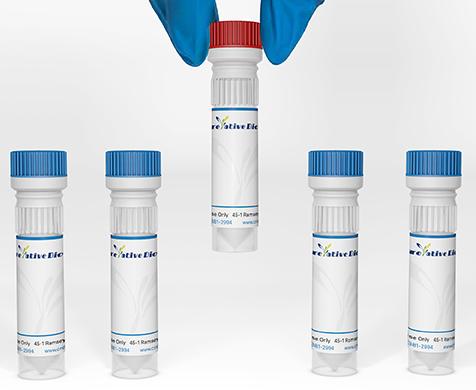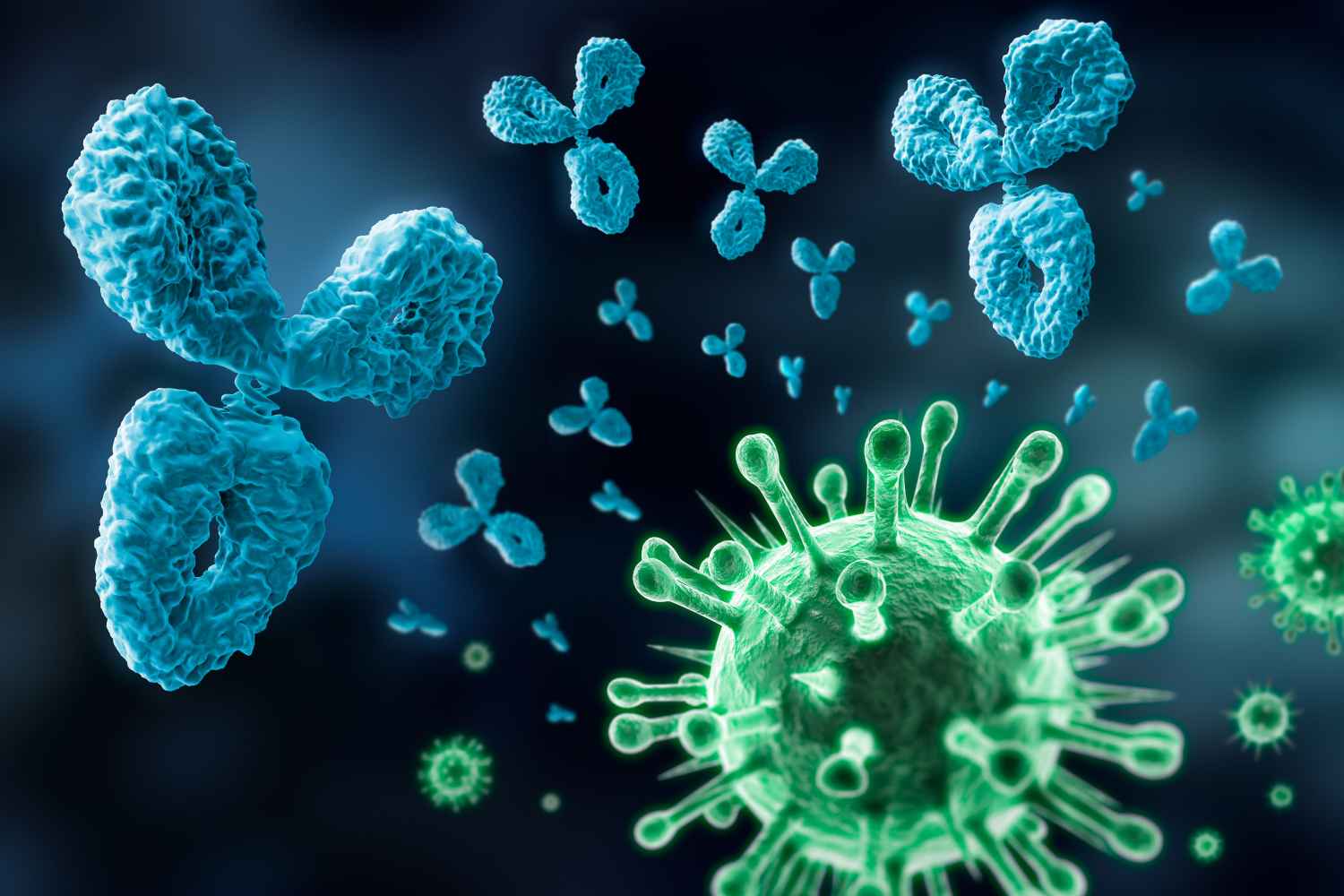Phospho-RIPK3 (Ser227)
The product of this gene is a member of the receptor-interacting protein (RIP) family of serine/threonine protein kinases, and contains a C-terminal domain unique from other RIP family members. The encoded protein is predominantly localized to the cytoplasm, and can undergo nucleocytoplasmic shuttling dependent on novel nuclear localization and export signals. It is a component of the tumor necrosis factor (TNF) receptor-I signaling complex, and can induce apoptosis and weakly activate the NF-kappaB transcription factor. [provided by RefSeq, Jul 2008]
Full Name
Receptor Interacting Serine/Threonine Kinase 3
Function
Serine/threonine-protein kinase that activates necroptosis and apoptosis, two parallel forms of cell death (PubMed:19524512, PubMed:19524513, PubMed:22265413, PubMed:22265414, PubMed:22421439, PubMed:29883609, PubMed:32657447).
Necroptosis, a programmed cell death process in response to death-inducing TNF-alpha family members, is triggered by RIPK3 following activation by ZBP1 (PubMed:19524512, PubMed:19524513, PubMed:22265413, PubMed:22265414, PubMed:22421439, PubMed:29883609, PubMed:32298652).
Activated RIPK3 forms a necrosis-inducing complex and mediates phosphorylation of MLKL, promoting MLKL localization to the plasma membrane and execution of programmed necrosis characterized by calcium influx and plasma membrane damage (PubMed:19524512, PubMed:19524513, PubMed:22265413, PubMed:22265414, PubMed:22421439, PubMed:25316792, PubMed:29883609).
In addition to TNF-induced necroptosis, necroptosis can also take place in the nucleus in response to orthomyxoviruses infection: following ZBP1 activation, which senses double-stranded Z-RNA structures, nuclear RIPK3 catalyzes phosphorylation and activation of MLKL, promoting disruption of the nuclear envelope and leakage of cellular DNA into the cytosol (By similarity).
Also regulates apoptosis: apoptosis depends on RIPK1, FADD and CASP8, and is independent of MLKL and RIPK3 kinase activity (By similarity).
Phosphorylates RIPK1: RIPK1 and RIPK3 undergo reciprocal auto- and trans-phosphorylation (PubMed:19524513).
In some cell types, also able to restrict viral replication by promoting cell death-independent responses (By similarity).
In response to Zika virus infection in neurons, promotes a cell death-independent pathway that restricts viral replication: together with ZBP1, promotes a death-independent transcriptional program that modifies the cellular metabolism via up-regulation expression of the enzyme ACOD1/IRG1 and production of the metabolite itaconate (By similarity).
Itaconate inhibits the activity of succinate dehydrogenase, generating a metabolic state in neurons that suppresses replication of viral genomes (By similarity).
RIPK3 binds to and enhances the activity of three metabolic enzymes: GLUL, GLUD1, and PYGL (PubMed:19498109).
These metabolic enzymes may eventually stimulate the tricarboxylic acid cycle and oxidative phosphorylation, which could result in enhanced ROS production (PubMed:19498109).
(Microbial infection) In case of herpes simplex virus 1/HHV-1 infection, forms heteromeric amyloid structures with HHV-1 protein RIR1/ICP6 which may inhibit RIPK3-mediated necroptosis, thereby preventing host cell death pathway and allowing viral evasion.
Necroptosis, a programmed cell death process in response to death-inducing TNF-alpha family members, is triggered by RIPK3 following activation by ZBP1 (PubMed:19524512, PubMed:19524513, PubMed:22265413, PubMed:22265414, PubMed:22421439, PubMed:29883609, PubMed:32298652).
Activated RIPK3 forms a necrosis-inducing complex and mediates phosphorylation of MLKL, promoting MLKL localization to the plasma membrane and execution of programmed necrosis characterized by calcium influx and plasma membrane damage (PubMed:19524512, PubMed:19524513, PubMed:22265413, PubMed:22265414, PubMed:22421439, PubMed:25316792, PubMed:29883609).
In addition to TNF-induced necroptosis, necroptosis can also take place in the nucleus in response to orthomyxoviruses infection: following ZBP1 activation, which senses double-stranded Z-RNA structures, nuclear RIPK3 catalyzes phosphorylation and activation of MLKL, promoting disruption of the nuclear envelope and leakage of cellular DNA into the cytosol (By similarity).
Also regulates apoptosis: apoptosis depends on RIPK1, FADD and CASP8, and is independent of MLKL and RIPK3 kinase activity (By similarity).
Phosphorylates RIPK1: RIPK1 and RIPK3 undergo reciprocal auto- and trans-phosphorylation (PubMed:19524513).
In some cell types, also able to restrict viral replication by promoting cell death-independent responses (By similarity).
In response to Zika virus infection in neurons, promotes a cell death-independent pathway that restricts viral replication: together with ZBP1, promotes a death-independent transcriptional program that modifies the cellular metabolism via up-regulation expression of the enzyme ACOD1/IRG1 and production of the metabolite itaconate (By similarity).
Itaconate inhibits the activity of succinate dehydrogenase, generating a metabolic state in neurons that suppresses replication of viral genomes (By similarity).
RIPK3 binds to and enhances the activity of three metabolic enzymes: GLUL, GLUD1, and PYGL (PubMed:19498109).
These metabolic enzymes may eventually stimulate the tricarboxylic acid cycle and oxidative phosphorylation, which could result in enhanced ROS production (PubMed:19498109).
(Microbial infection) In case of herpes simplex virus 1/HHV-1 infection, forms heteromeric amyloid structures with HHV-1 protein RIR1/ICP6 which may inhibit RIPK3-mediated necroptosis, thereby preventing host cell death pathway and allowing viral evasion.
Biological Process
Activation of protein kinase activityManual Assertion Based On ExperimentIMP:UniProtKB
Amyloid fibril formationManual Assertion Based On ExperimentIMP:UniProtKB
Apoptotic signaling pathwayManual Assertion Based On ExperimentTAS:ProtInc
Cellular protein modification processManual Assertion Based On ExperimentTAS:ProtInc
Cellular response to hydrogen peroxideISS:ARUK-UCL
Defense response to virusISS:UniProtKB
Execution phase of necroptosisISS:UniProtKB
I-kappaB kinase/NF-kappaB signalingIEA:Ensembl
Lymph node developmentISS:UniProtKB
Necroptotic processManual Assertion Based On ExperimentIMP:UniProtKB
Necroptotic signaling pathwayManual Assertion Based On ExperimentIMP:UniProtKB
Positive regulation of intrinsic apoptotic signaling pathwayIEA:Ensembl
Positive regulation of ligase activityIEA:Ensembl
Positive regulation of necroptotic processManual Assertion Based On ExperimentIDA:UniProtKB
Positive regulation of NF-kappaB transcription factor activityManual Assertion Based On ExperimentIDA:UniProtKB
Positive regulation of oxidoreductase activityIEA:Ensembl
Positive regulation of phosphatase activityManual Assertion Based On ExperimentIMP:UniProtKB
Positive regulation of reactive oxygen species metabolic processIEA:EnsemblProgrammed necrotic cell deathISS:ARUK-UCL
Protein autophosphorylationManual Assertion Based On ExperimentIDA:UniProtKB
Regulation of activated T cell proliferationISS:UniProtKB
Regulation of activation-induced cell death of T cellsISS:UniProtKB
Regulation of adaptive immune responseISS:UniProtKB
Regulation of apoptotic processISS:UniProtKB
Regulation of CD8-positive, alpha-beta cytotoxic T cell extravasationISS:UniProtKB
Regulation of interferon-gamma productionISS:UniProtKB
Regulation of T cell mediated cytotoxicityISS:UniProtKB
Signal transductionManual Assertion Based On ExperimentIBA:GO_Central
Spleen developmentISS:UniProtKB
T cell differentiation in thymusISS:UniProtKB
T cell homeostasisISS:UniProtKB
Thymus developmentISS:UniProtKB
Amyloid fibril formationManual Assertion Based On ExperimentIMP:UniProtKB
Apoptotic signaling pathwayManual Assertion Based On ExperimentTAS:ProtInc
Cellular protein modification processManual Assertion Based On ExperimentTAS:ProtInc
Cellular response to hydrogen peroxideISS:ARUK-UCL
Defense response to virusISS:UniProtKB
Execution phase of necroptosisISS:UniProtKB
I-kappaB kinase/NF-kappaB signalingIEA:Ensembl
Lymph node developmentISS:UniProtKB
Necroptotic processManual Assertion Based On ExperimentIMP:UniProtKB
Necroptotic signaling pathwayManual Assertion Based On ExperimentIMP:UniProtKB
Positive regulation of intrinsic apoptotic signaling pathwayIEA:Ensembl
Positive regulation of ligase activityIEA:Ensembl
Positive regulation of necroptotic processManual Assertion Based On ExperimentIDA:UniProtKB
Positive regulation of NF-kappaB transcription factor activityManual Assertion Based On ExperimentIDA:UniProtKB
Positive regulation of oxidoreductase activityIEA:Ensembl
Positive regulation of phosphatase activityManual Assertion Based On ExperimentIMP:UniProtKB
Positive regulation of reactive oxygen species metabolic processIEA:EnsemblProgrammed necrotic cell deathISS:ARUK-UCL
Protein autophosphorylationManual Assertion Based On ExperimentIDA:UniProtKB
Regulation of activated T cell proliferationISS:UniProtKB
Regulation of activation-induced cell death of T cellsISS:UniProtKB
Regulation of adaptive immune responseISS:UniProtKB
Regulation of apoptotic processISS:UniProtKB
Regulation of CD8-positive, alpha-beta cytotoxic T cell extravasationISS:UniProtKB
Regulation of interferon-gamma productionISS:UniProtKB
Regulation of T cell mediated cytotoxicityISS:UniProtKB
Signal transductionManual Assertion Based On ExperimentIBA:GO_Central
Spleen developmentISS:UniProtKB
T cell differentiation in thymusISS:UniProtKB
T cell homeostasisISS:UniProtKB
Thymus developmentISS:UniProtKB
Cellular Location
Cytoplasm, cytosol
Nucleus
Mainly cytoplasmic. Present in the nucleus in response to influenza A virus (IAV) infection.
Nucleus
Mainly cytoplasmic. Present in the nucleus in response to influenza A virus (IAV) infection.
PTM
(Microbial infection) Proteolytically cleaved by S.flexneri OspD3 within the RIP homotypic interaction motif (RHIM), leading to its degradation and inhibition of necroptosis.
RIPK1 and RIPK3 undergo reciprocal auto- and trans-phosphorylation (PubMed:19524513).
Autophosphorylated following interaction with ZBP1 (By similarity).
Phosphorylation of Ser-199 plays a role in the necroptotic function of RIPK3 (PubMed:11734559, PubMed:19524512).
Autophosphorylates at Ser-227 following activation by ZBP1: phosphorylation at these sites is a hallmark of necroptosis and is required for binding MLKL (PubMed:22265413).
Phosphorylation at Thr-182 is important for its kinase activity, interaction with PELI1 and PELI1-mediated 'Lys-48'-linked polyubiquitination and for its ability to mediate TNF-induced necroptosis (PubMed:29883609).
Polyubiquitinated with 'Lys-48' and 'Lys-63'-linked chains by BIRC2/c-IAP1 and BIRC3/c-IAP2, leading to activation of NF-kappa-B (PubMed:21931591).
Polyubiquitinated with 'Lys-48'-linked chains by PELI1 leading to its subsequent proteasome-dependent degradation. Ubiquitinated by STUB1 leading to its subsequent proteasome-dependent degradation (PubMed:29883609).
RIPK1 and RIPK3 undergo reciprocal auto- and trans-phosphorylation (PubMed:19524513).
Autophosphorylated following interaction with ZBP1 (By similarity).
Phosphorylation of Ser-199 plays a role in the necroptotic function of RIPK3 (PubMed:11734559, PubMed:19524512).
Autophosphorylates at Ser-227 following activation by ZBP1: phosphorylation at these sites is a hallmark of necroptosis and is required for binding MLKL (PubMed:22265413).
Phosphorylation at Thr-182 is important for its kinase activity, interaction with PELI1 and PELI1-mediated 'Lys-48'-linked polyubiquitination and for its ability to mediate TNF-induced necroptosis (PubMed:29883609).
Polyubiquitinated with 'Lys-48' and 'Lys-63'-linked chains by BIRC2/c-IAP1 and BIRC3/c-IAP2, leading to activation of NF-kappa-B (PubMed:21931591).
Polyubiquitinated with 'Lys-48'-linked chains by PELI1 leading to its subsequent proteasome-dependent degradation. Ubiquitinated by STUB1 leading to its subsequent proteasome-dependent degradation (PubMed:29883609).
View more
Anti-Phospho-RIPK3 (Ser227) antibodies
+ Filters
 Loading...
Loading...
Target: Phospho-RIPK3 (Ser227)
Host: Rabbit
Antibody Isotype: IgG
Specificity: Human
Clone: D6W2T
Application*: WB, IF (IC)
More Infomation
Hot products 
-
Mouse Anti-BrdU Recombinant Antibody (IIB5) (CBMAB-1038CQ)

-
Mouse Anti-dsRNA Recombinant Antibody (2) (CBMAB-D1807-YC)

-
Rabbit Anti-ABL1 (Phosphorylated Y185) Recombinant Antibody (V2-443434) (PTM-CBMAB-0001YC)

-
Rat Anti-CCR2 Recombinant Antibody (475301) (CBMAB-C1338-LY)

-
Mouse Anti-ACLY Recombinant Antibody (V2-179314) (CBMAB-A0610-YC)

-
Mouse Anti-Acetyl-α-Tubulin (Lys40) Recombinant Antibody (V2-623485) (CBMAB-CP2897-LY)

-
Rabbit Anti-BAD (Phospho-Ser136) Recombinant Antibody (CAP219) (CBMAB-AP536LY)

-
Mouse Anti-ACTN4 Recombinant Antibody (V2-6075) (CBMAB-0020CQ)

-
Human Anti-SARS-CoV-2 Spike Recombinant Antibody (CR3022) (CBMAB-CR014LY)

-
Mouse Anti-COL1A2 Recombinant Antibody (CF108) (V2LY-1206-LY626)

-
Mouse Anti-ADGRE5 Recombinant Antibody (V2-360335) (CBMAB-C2088-CQ)

-
Rat Anti-(1-5)-α-L-Arabinan Recombinant Antibody (V2-501861) (CBMAB-XB0003-YC)

-
Mouse Anti-ARG1 Recombinant Antibody (CBYCL-103) (CBMAB-L0004-YC)

-
Mouse Anti-8-oxoguanine Recombinant Antibody (V2-7697) (CBMAB-1869CQ)

-
Mouse Anti-BZLF1 Recombinant Antibody (BZ.1) (CBMAB-AP705LY)

-
Mouse Anti-CARD11 Recombinant Antibody (CBFYC-0811) (CBMAB-C0866-FY)

-
Mouse Anti-4-Hydroxynonenal Recombinant Antibody (V2-502280) (CBMAB-C1055-CN)

-
Mouse Anti-EPO Recombinant Antibody (CBFYR0196) (CBMAB-R0196-FY)

-
Mouse Anti-ALDOA Recombinant Antibody (A2) (CBMAB-A2316-YC)

-
Rat Anti-ADGRE4 Recombinant Antibody (V2-160163) (CBMAB-F0011-CQ)

For Research Use Only. Not For Clinical Use.
(P): Predicted
* Abbreviations
- AActivation
- AGAgonist
- APApoptosis
- BBlocking
- BABioassay
- BIBioimaging
- CImmunohistochemistry-Frozen Sections
- CIChromatin Immunoprecipitation
- CTCytotoxicity
- CSCostimulation
- DDepletion
- DBDot Blot
- EELISA
- ECELISA(Cap)
- EDELISA(Det)
- ESELISpot
- EMElectron Microscopy
- FFlow Cytometry
- FNFunction Assay
- GSGel Supershift
- IInhibition
- IAEnzyme Immunoassay
- ICImmunocytochemistry
- IDImmunodiffusion
- IEImmunoelectrophoresis
- IFImmunofluorescence
- IGImmunochromatography
- IHImmunohistochemistry
- IMImmunomicroscopy
- IOImmunoassay
- IPImmunoprecipitation
- ISIntracellular Staining for Flow Cytometry
- LALuminex Assay
- LFLateral Flow Immunoassay
- MMicroarray
- MCMass Cytometry/CyTOF
- MDMeDIP
- MSElectrophoretic Mobility Shift Assay
- NNeutralization
- PImmunohistologyp-Paraffin Sections
- PAPeptide Array
- PEPeptide ELISA
- PLProximity Ligation Assay
- RRadioimmunoassay
- SStimulation
- SESandwich ELISA
- SHIn situ hybridization
- TCTissue Culture
- WBWestern Blot

Online Inquiry





